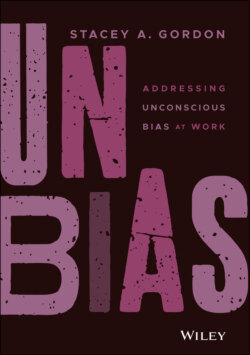Читать книгу UNBIAS - Stacey A. Gordon - Страница 9
The Framework of the Blueprint
ОглавлениеI work to remove barriers and reduce bias as a mission, but my mission is only successful when yours is too. The blueprint I work from is my own strategy that, when applied across the commonalities of business, provides a place from which to measure how close you are to achieving your goal. In my experience working with thousands of employees at companies around the globe, I have encountered common themes, common challenges, and common solutions that run across industries, across company sizes, and across cultures.
The basic framework is the same for each organization, whether you have one hundred employees or one hundred thousand. Where the difference lies is in the implementation. With the opportunity to observe actions and behaviors, as well as to begin to recognize the mindsets that drive them, I have been able to classify companies into four main levels or phases: Awareness, Alignment, Action, and Advocacy.
The categories collectively characterize the practices, policies, and procedures that an organization needs to address and the order in which to do it. While the concepts around diversity and inclusion may come from a U.S.‐centric lens, they are applicable globally. I also use the term “inclusive workplace” to refer to the concept that company leaders must create a culture that is accepting of individual differences. However, when you consider the vast number of dimensions of diversity in the Four Layers model (see Figure 1.1), you can see they influence each other, which is why intersectionality is so important (but I'm getting ahead of myself). That convergence and influence of dimensions is what can make this work seem difficult, and as you'll hear me say repeatedly, “Complex doesn't have to mean difficult and it definitely isn't impossible.”
You've probably also heard it said that you cannot have inclusion without diversity, but you cannot have an inclusive workplace culture without an organization that respects the diversity of the individuals, acknowledges the value that diversity brings to the organization, and actively works to ensure all employees within the organization are included in the practices, policies, and procedures of the workplace.
FIGURE 1.1 The Four Layers of Diversity.
Sources: Lee Gardenswartz and Anita Rowe, Diverse Teams at Work, 2nd Edition (Society for Human Resource Management, 2003); Adapted from Marilyun Loden and Judy Rosener, Workforce America (Business One Irwin, 1991).
